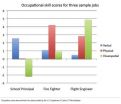Ingredient in soap points toward new drugs for infection that affects 2 billion
2010-09-22
(Press-News.org) The antibacterial ingredient in some soaps, toothpastes, odor-fighting socks, and even computer keyboards is pointing scientists toward a long-sought new treatment for a parasitic disease that affects almost two billion people. Their report on how triclosan became the guiding light for future development of drugs for toxoplasmosis appears in ACS' monthly Journal of Medicinal Chemistry.
In the study, Rima McLeod and colleagues point out that toxoplasmosis is one of the world's most common parasitic infections, affecting about one-third of the world population, including 80 percent of the population of Brazil. People can catch the infection, spread by the parasite Toxoplasma gondii (T. gondii), from contact with feces from infected cats, eating raw or undercooked meat, and in other ways. Many have no symptoms because their immune systems keep the infection under control and the parasite remains inactive. But it can cause eye damage and other problems, even becoming life threatening in individuals with immune systems weakened by certain medications and diseases like HIV infection, which allow the parasite to become active again, and in some persons without immune compromise. Most current treatments have some potentially harmful side effects and none of them attack the parasite in its inactive stage.
The scientists knew from past research that triclosan has a powerful effect in blocking the action of a key enzyme that T. gondii uses to live. Triclosan, however, cannot be used as a medication because it does not dissolve in the blood. The scientists describe using triclosan's molecular structure as the model for developing other potential medications, including some that show promise as more effective treatments for the disease.
INFORMATION:ARTICLE FOR IMMEDIATE RELEASE
"Identification and Development of Novel Inhibitors of Toxoplasma gondii Enoyl Reductase"
DOWNLOAD FULL TEXT ARTICLE
http://pubs.acs.org/stoken/presspac/presspac/abs/10.1021/jm9017724
CONTACT:
Rima McLeod, M.D.
Biological Sciences Division
The University of Chicago
AMB S206, (MC 2114)
5841 South Maryland Avenue
Chicago, IL 60637
Phone: 773-834-4130
Fax: 773-834-3577
Email: rmcleod@midway.uchicago.edu
END
ELSE PRESS RELEASES FROM THIS DATE:
2010-09-22
Researchers from the Cardiac & Vascular Institute at NYU Langone Medical Center will present at the Transcatheter Cardiovascular Therapeutics (TCT) 2010 scientific symposium on September 21-25, 2010 in Washington, DC. They will be available for interviews during the conference.
Louis Miller, MD
Interventional Cardiology Fellow, Department of Medicine, Leon H. Charney Division of Cardiology at NYU Langone Medical Center
Wednesday, September 22, 2010
Presenter
•Very Long-term Clinical Follow-up After Fractional Flow Reserve-Guided Coronary Revascularization, ...
2010-09-22
An unusual substance known as "dry water," which resembles powdered sugar, could provide a new way to absorb and store carbon dioxide, the major greenhouse gas that contributes to global warming, scientists reported at the 240th National Meeting of the American Chemical Society. The powder shows bright promise for a number of other uses, they said. It may, for instance, be a greener, more energy-efficient way of jump-starting the chemical reactions used to make hundreds of consumer products. Dry water also could provide a safer way to store and transport potentially harmful ...
2010-09-22
COLUMBIA, Mo. – Although obesity is a major risk factor for disease, much of the threat may be associated with the metabolic (or cardiometabolic) syndrome, a cluster of risk factors related to diabetes and heart disease. Losing weight can improve health and reduce many of these risk factors. However, many people struggle to keep the weight off long-term. Now, researchers at the University of Missouri have found that people who perform resistance training while regaining weight can help maintain strides in reducing their risks for chronic disease.
"Long-term weight loss ...
2010-09-22
Imagine devices that capture electricity from the air — much like solar cells capture sunlight — and using them to light a house or recharge an electric car. Imagine using similar panels on the rooftops of buildings to prevent lightning before it forms. Strange as it may sound, scientists already are in the early stages of developing such devices, according to a report at the 240th National Meeting of the American Chemical Society.
"Our research could pave the way for turning electricity from the atmosphere into an alternative energy source for the future," said study ...
2010-09-22
Portable devices that use a laser beam to probe bones, teeth, and other parts of the body for early signs of diseases like osteoporosis and tooth decay may seem like something out of science fiction. But those devices are moving closer to reality, according to an article in the current issue of Chemical & Engineering News (C&EN), ACS' weekly newsmagazine.
C&EN Senior Editor Celia Henry Arnaud notes that these new diagnostic tools will have the ability to see beneath the skin and detect disease, without exposing patients to X-rays. They embrace a technology that involves ...
2010-09-22
Toronto, Canada – In an international study of patients with a devastating type of dementia that often strikes in middle age, researchers have found intriguing evidence that career choice may influence where the disease takes root in the brain.
The study was led by Baycrest's Rotman Research Institute in collaboration with the Memory and Aging Centre at the University of California, San Francisco and several U.S. and European clinical sites. It appears online today in the Article in Press section of the journal Neuropsychologia, ahead of publication.
Researchers ...
2010-09-22
A study led by St. Jude Children's Research Hospital investigators links the muscle weakness and other symptoms of a rare neurodegenerative disease to a misstep in functioning of a normal protein, rather than its build-up inside cells. The finding offers insight into the mechanism driving common nervous system disorders like Parkinson's and Alzheimer's diseases.
The work advances understanding of how the inherited mistake at the heart of spinobulbar muscular atrophy (SBMA) leads to the death of neurons in the brain and spinal cord. Investigators showed that the underlying ...
2010-09-22
September 22, 2010 -- Most studies of the food choices available near public schools have focused on fast food outlets rather than the full range of options available to schoolchildren. A new study by researchers at Columbia University's Mailman School of Public Health examined the patterns of exposure to a broad range of food outlets for school children in New York City.
The study, "Disparities in the Food Environments of New York City Public Schools," is published in the American Journal of Preventive Medicine Volume 39, Issue 3, and cited as the "Editor's Choice" ...
2010-09-22
Bethesda, Md. (September 22, 2010) – Taking chromium picolinate may help lessen inflammation associated with diabetic nephropathy (kidney disease), say researchers at the Medical College of Georgia in Augusta. In a study comparing diabetic mice treated with chromium picolinate with those that received placebo, the researchers found that mice who received the supplement had lower levels of albuminuria (protein in the urine), an indication of kidney disease.
The Study
To arrive at their conclusions, the researchers compared three groups of mice, one lean, healthy group ...
2010-09-22
(Santa Barbara, Calif.) –– Sometimes, treasures can be found in your own backyard –– especially if you know what to look for. This is what happened to Jeff Goddard, project scientist with the Marine Science Institute at UC Santa Barbara.
Goddard was working in the tide pools at Carpinteria Reef, in Carpinteria State Park, Calif., when he found a new species of nudibranch –– a group of sea slugs noted for their bright colors and delicate forms. Recognizing it as new, Goddard carefully documented the living specimen before preserving it and sending it off to Terrence M. ...
LAST 30 PRESS RELEASES:
[Press-News.org] Ingredient in soap points toward new drugs for infection that affects 2 billion


